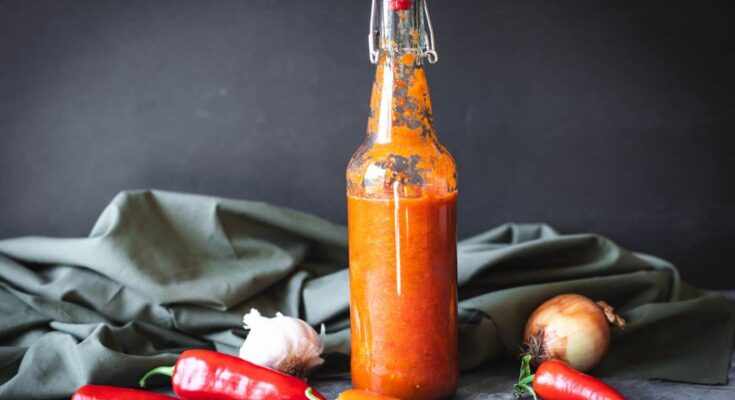Fermented Hot Sauce Recipe: Fermented hot sauce is not just another fiery condiment—it’s a flavorful masterpiece crafted through the ancient art of fermentation. Unlike store-bought sauces that rely heavily on vinegar and preservatives, a fermented hot sauce develops its character slowly, thanks to the magical work of natural bacteria. When peppers, garlic, onions, or other vegetables are submerged in a saltwater brine, lactic acid bacteria begin breaking down the natural sugars. This process results in a complex, tangy, and deeply satisfying flavor that vinegar-based sauces simply can’t replicate.
What makes fermentation so special is the balance of heat and depth of flavor. Instead of hitting you with just spiciness, fermented hot sauce delivers a rounded taste—spicy, tangy, slightly sour, and sometimes even a little sweet. If you’ve ever tasted a bottle of artisan fermented hot sauce, you know it has a richness and depth that keeps you coming back for more.
But it’s not just about flavor. Fermented hot sauce is also packed with probiotics that can benefit your gut health. Think of it as combining the bold punch of chili peppers with the digestive benefits of fermented foods like kimchi, sauerkraut, or kombucha. It’s flavor and function in a single bottle.
So, why should you make your own? Simple: you get full control over the heat level, flavor combinations, and fermentation time. Whether you love a fiery habanero kick or a milder jalapeño tang, you can create a sauce that perfectly matches your taste buds. Plus, it’s surprisingly easy once you understand the process—and the reward is a homemade hot sauce that’s fresher and healthier than anything you can buy at the store.
Ingredients You’ll Need for Fermented Hot Sauce
Before diving into the step-by-step process, let’s get your pantry ready. The beauty of fermented hot sauce is its flexibility. You can stick with the basics or go wild with flavor experiments. At its core, the recipe is simple: peppers, garlic, salt, and water. From there, the possibilities are endless.
Essential Ingredients
- Fresh chili peppers (jalapeños, habaneros, Thai chilies, cayenne, or a mix)
- Garlic cloves (for depth and aroma)
- Onion or shallots (optional, but adds sweetness)
- Non-iodized salt (like sea salt or kosher salt)
- Filtered water (chlorine-free for proper fermentation)
Optional Add-Ins for Flavor Enhancement
- Carrots – add natural sweetness and color
- Fruit (mango, pineapple, apple, peach) – for a tropical or tangy twist
- Spices (cumin, coriander, smoked paprika) – for earthy, smoky undertones
- Herbs (cilantro, parsley, oregano) – add freshness and complexity
Tools and Equipment Required
- Glass fermentation jars (Mason jars work perfectly)
- Fermentation weights or small glass inserts to keep ingredients submerged
- Airlock lids or loose lids (to let gas escape)
- Blender or food processor (for final sauce texture)
- Gloves (to protect your hands from chili burn)
With these ingredients and tools ready, you’re well-equipped to start your hot sauce journey.
Preparing Your Ingredients
The secret to a great fermented hot sauce starts with quality preparation. Freshness matters—a lot. Choose peppers that are firm, vibrant, and free from blemishes. Whether you prefer fiery habaneros, smoky chipotles, or mild jalapeños, your choice of pepper will set the foundation for your sauce’s flavor and heat profile.
First, wash your peppers, garlic, onions, and any optional add-ins thoroughly. Even though fermentation is a natural preservation process, you want to minimize unwanted bacteria. Slice your peppers into halves or quarters, removing stems but keeping the seeds if you want maximum heat. If you prefer a milder sauce, remove some or all of the seeds and inner membranes.
Next, think about aromatics. Garlic and onions are classic partners to chili peppers because they add layers of flavor. Garlic deepens the richness, while onions balance the sharp heat with subtle sweetness. If you want to add carrots, they’ll not only bring color but also mellow out the intensity. Fruits like pineapple or mango can bring an exciting tropical tang that complements the spice beautifully.
It’s all about balance—heat, sweetness, tang, and earthiness. Preparing your ingredients properly ensures that your hot sauce will ferment evenly and develop a well-rounded taste. Once everything is chopped and ready, you’re set for the fun part: fermentation.
Step-by-Step Fermented Hot Sauce Guide
Here’s where the magic happens. Fermentation is simple, but attention to detail makes all the difference. Follow these steps closely, and you’ll be rewarded with a flavorful hot sauce that outshines anything store-bought.
Step 1 – Create the Brine Solution
Mix non-iodized salt with filtered water. The general rule is about 3% salt by weight of water (roughly 1 tablespoon of salt per 2 cups of water). This brine not only kickstarts fermentation but also prevents harmful bacteria from growing.
Step 2 – Packing the Ingredients into Jars
Pack your chopped peppers, garlic, and other chosen ingredients into a clean glass jar. Pour the brine over until everything is submerged. Use fermentation weights to push ingredients under the liquid—this is key because exposure to air can cause mold.
Step 3 – Monitoring the Fermentation Process
Seal the jar with an airlock lid or a loosely screwed lid. Place it in a cool, dark place (65–75°F is ideal). Over the next few days, you’ll notice bubbles forming and the brine becoming cloudy—that’s good! It means fermentation is working. Burp the jar daily if not using an airlock to release gas buildup.
Step 4 – Blending the Sauce After Fermentation
After your desired fermentation time (anywhere from 1 to 4 weeks), strain out the solids and blend them with some of the brine until smooth. Taste-test, adjust with vinegar or spices if desired, and transfer to clean bottles. Congratulations—you’ve just made your own fermented hot sauce!
Flavor Variations of Fermented Hot Sauce
Fermentation opens up a playground of flavor possibilities. Once you master the basic recipe, experiment with creative variations to suit different dishes and palates.
Smoky Chipotle Style
Use dried chipotle peppers and smoked paprika for a rich, smoky flavor perfect for BBQ dishes.
Sweet and Spicy Mango Blend
Add ripe mangoes or pineapple to balance fiery peppers with tropical sweetness. Ideal for tacos or grilled chicken.
Garlic and Herb Infused Hot Sauce
Double up on garlic and toss in fresh herbs like oregano or cilantro for a zesty, aromatic sauce that pairs wonderfully with Mediterranean dishes.
How Long Should You Ferment Hot Sauce?
Fermentation time is one of the biggest factors that determine the flavor and intensity of your hot sauce. Some people love a quick, bright-tasting sauce, while others prefer a deeply complex flavor that comes from a longer fermentation. The great thing is—you get to decide how long to ferment depending on your taste preference.
Short-Term Fermentation (3–7 Days)
If you’re new to fermentation or simply impatient, a shorter fermentation might be your style. Within a week, the peppers and other ingredients will have started breaking down, producing a tangy yet still vibrant flavor. Short ferments tend to keep more of the raw pepper taste and a brighter, fresher heat.
This method is perfect for those who want a quick turnaround or don’t want an overpowering sourness. Think of it as a halfway point between a fresh hot sauce and a deeply fermented one. You’ll still get beneficial probiotics, but the flavors won’t be as developed as they could be with more time.
Long-Term Fermentation (2–4 Weeks)
If you’re after complexity, patience is your friend. Allowing your hot sauce to ferment for a few weeks creates deeper, funkier, and more balanced flavors. The peppers mellow, the tanginess intensifies, and the sauce develops a richness you can’t achieve with short-term ferments.
Many hot sauce makers consider the sweet spot to be around 2–3 weeks, though some adventurous fermenters let their jars sit for months. The longer you wait, the stronger the flavor—but also the more sourness you’ll get.
Signs of Proper Fermentation
So, how do you know when it’s ready? Look for these signs:
- Bubbles rising to the top (active fermentation).
- Cloudy brine (a natural byproduct of lactic acid bacteria).
- Pleasant sour smell (tangy, not rotten or moldy).
- Slight fizz when you open the jar (like a carbonated drink).
If your sauce smells bad, looks moldy, or has fuzzy growths on top, it’s best to toss it. But with proper care, these issues are rare.
Safety Tips for Fermenting Hot Sauce
Fermentation is generally safe, but mistakes can lead to spoiled batches. To make sure your hot sauce comes out delicious every time, follow these safety tips.
Preventing Mold Growth
Mold forms when ingredients are exposed to air. That’s why it’s critical to keep everything fully submerged under brine. Use fermentation weights, a clean rock, or even a small ziplock bag filled with brine to push vegetables under the liquid. Always check daily to ensure nothing is floating to the top.
Correct Salt Ratios
Salt isn’t just for flavor—it’s essential for controlling the fermentation process. Too little salt and harmful bacteria might grow. Too much salt, and fermentation slows down. Stick to around 2–3% salt by weight of your water for best results.
Using Fermentation Weights and Airlocks
An airlock system is handy because it lets gases escape without letting air back in. If you don’t have one, a loosely fitted jar lid works, but you’ll need to “burp” the jar daily to prevent gas buildup. Always keep your jars clean and sterilized before starting.
These safety precautions may sound like extra steps, but they’re the key to consistent, flavorful results. Once you get comfortable, making fermented hot sauce will feel second nature.
Bottling and Storing Your Hot Sauce
After fermentation and blending, it’s time to store your masterpiece. Proper bottling and storage keep your sauce fresh and flavorful for months, sometimes even years.
Choosing the Right Bottles
The best choice is glass bottles with airtight caps. Swing-top bottles or hot sauce squeeze bottles work perfectly. Avoid plastic containers, as they can absorb odors and stain.
How to Pasteurize Hot Sauce (Optional)
If you want a longer shelf life and don’t care about preserving probiotics, pasteurizing is an option. Simply simmer your finished sauce in a saucepan until it reaches about 185°F (85°C), then transfer it to sterilized bottles. Pasteurization kills the beneficial bacteria but ensures no further fermentation occurs.
Storage Tips for Maximum Freshness
- Store refrigerated for up to 6 months (unpasteurized).
- Store in a pantry for 1 year or more (if pasteurized).
- Always shake before use, as natural separation is normal.
Whether you keep it probiotic-rich or heat-treated, your homemade hot sauce will be fresher and more flavorful than anything store-bought.
Serving Suggestions and Uses
Now comes the fun part—eating it! Fermented hot sauce isn’t just for tacos or eggs. Its complex tangy heat makes it a versatile addition to countless meals.
Adding Heat to Daily Meals
Drizzle it over scrambled eggs, avocado toast, pizza, or even popcorn. The probiotic tang lifts the flavor of simple dishes.
Pairing with Different Cuisines
- Mexican food – Tacos, burritos, and enchiladas.
- Asian dishes – Stir-fries, noodle bowls, or dumplings.
- BBQ – A smoky hot sauce works wonders on ribs or pulled pork.
- Seafood – A citrusy fermented hot sauce pairs beautifully with grilled shrimp or fish.
Creative Cooking Ideas with Hot Sauce
- Mix into mayo for a spicy aioli.
- Stir into soups or stews for an extra kick.
- Blend into salad dressings or marinades.
- Use as a base for spicy cocktails like Bloody Marys or Micheladas.
Once you start experimenting, you’ll find yourself reaching for your homemade fermented hot sauce every single day.
Health Benefits of Fermented Hot Sauce
This fiery condiment doesn’t just spice up your food—it also boosts your health.
Gut Health and Probiotics
Since fermentation encourages the growth of beneficial bacteria, your hot sauce becomes a natural probiotic food. These good microbes help balance your gut, improve digestion, and may even strengthen your immune system.
Nutritional Value of Chili Peppers
Chili peppers are loaded with vitamin C, vitamin A, potassium, and capsaicin. Capsaicin is the compound that makes peppers hot, and it has been linked to boosting metabolism and reducing inflammation.
Antioxidants and Immunity Boost
Both peppers and garlic are rich in antioxidants that fight free radicals in your body. This means your homemade sauce not only excites your taste buds but also contributes to your long-term health.
Common Mistakes to Avoid When Making Fermented Hot Sauce
Even though fermented hot sauce is fairly simple to make, a few missteps can ruin your batch. The good news? Most of these mistakes are easy to avoid once you know what to look out for.
Using Too Much or Too Little Salt
Salt is your best friend in fermentation. Too little, and you risk harmful bacteria taking over. Too much, and fermentation slows or even stops. Stick with the golden ratio: 2–3% salt by weight of water. For example, if you’re using 1 liter of water, add 20–30 grams of salt. This ensures a safe and healthy environment for good bacteria to thrive.
Ignoring Proper Hygiene
Fermentation relies on naturally occurring bacteria, but you don’t want the wrong kind getting in. Always wash your hands, clean your equipment, and sterilize jars before use. A dirty jar or cutting board can introduce unwanted microbes that spoil the sauce.
Over-Fermenting or Under-Fermenting
Leaving your hot sauce too short means the flavors won’t develop fully, while letting it sit for too long may result in an overly sour or unpleasant taste. Taste-test every few days after the first week. This way, you can stop fermentation exactly when the flavor hits your sweet spot.
Exposing Ingredients to Air
The number one cause of mold? Ingredients floating above the brine. Always make sure everything stays submerged. If you notice pieces rising to the surface, press them back down with a weight.
By avoiding these common mistakes, you’ll dramatically increase your chances of producing a flavorful, tangy, and safe hot sauce that you can proudly share with friends and family.
FAQs about Fermented Hot Sauce Recipe
1. Can I use any type of pepper?
Yes! Any chili pepper works—from mild jalapeños to fiery habaneros or ghost peppers. The flavor and heat level will vary, so choose based on your preference. You can even mix different peppers to create a unique blend.
2. How do I know if my sauce is safe to eat?
A properly fermented sauce should smell tangy and pleasantly sour, never rotten or foul. The brine may turn cloudy, and you might see bubbles—both are signs of healthy fermentation. If you see fuzzy mold, throw it out.
3. What’s the shelf life of homemade hot sauce?
Unpasteurized hot sauce lasts up to 6 months in the fridge, while pasteurized versions can last a year or more at room temperature. Always store in clean, airtight bottles.
4. Can I adjust the thickness of the sauce?
Absolutely. Blend longer for a smoother sauce or shorter for a chunkier texture. You can also add brine, vinegar, or fruit juice to thin it out to your liking.
5. Do I have to use vinegar at the end?
No, vinegar isn’t necessary, but adding it can enhance tanginess and extend shelf life. If you prefer a purely fermented flavor, skip it.
Conclusion
Fermented hot sauce is more than just a condiment—it’s a homemade flavor bomb that brings heat, tang, and depth to every meal. With just a few simple ingredients—peppers, garlic, salt, and water—you can create a sauce that’s not only delicious but also packed with probiotics and nutrients. The fermentation process may take some patience, but the reward is worth it: a unique, customizable hot sauce that’s fresher and healthier than anything you’ll find in a store.
Whether you prefer a quick, bright 5-day ferment or a deep, complex 3-week batch, you’re in full control of the flavor. With proper safety measures and a little creativity, you can experiment endlessly—adding fruits, herbs, or smoky spices to make your hot sauce truly one of a kind.
So, grab some peppers, prepare your brine, and start fermenting. Once you taste your own homemade fermented hot sauce, you’ll never go back to store-bought again.



